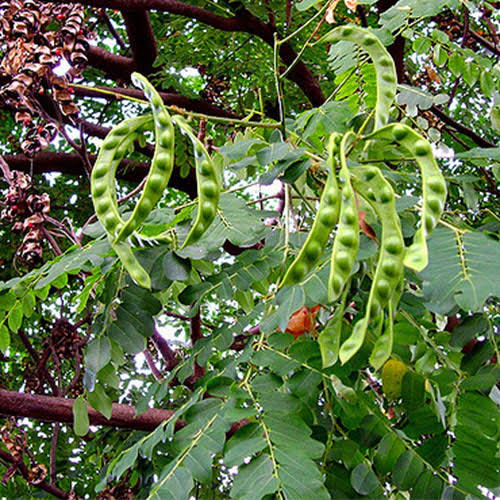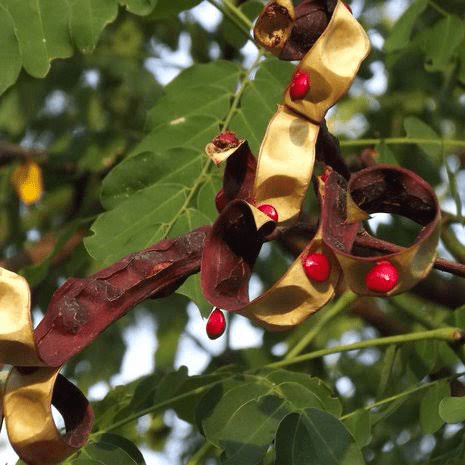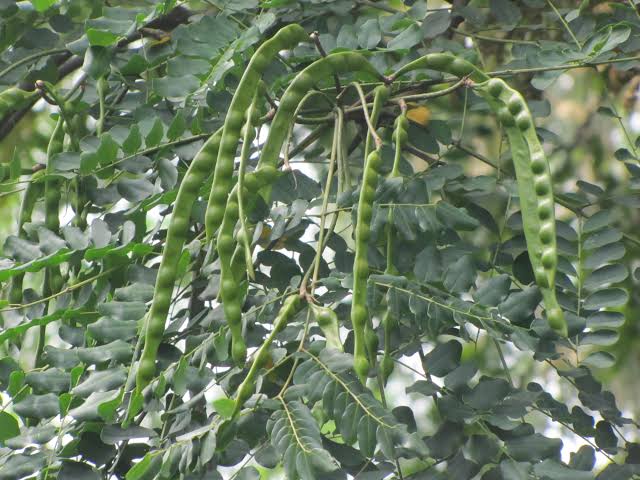Adenanthera pavonina, commonly known as the Red Sandalwood Tree, is a versatile medicinal plant that has been treasured for its various health benefits and historical significance.
The use of Adenanthera pavonina as a medicinal plant dates back thousands of years. It has been an integral part of traditional healing practices in many regions.
In TCM, Adenanthera pavonina is known as “Hong Teng.” It is highly regarded for its cooling properties and used to alleviate heat-related illnesses and inflammatory conditions.
In India, this plant is referred to as “Rakta Chandana” and plays a vital role in Ayurvedic medicine. It is used for its skin-soothing, anti-inflammatory, and digestive properties.
Indigenous communities in various parts of the world, including Southeast Asia, have used Adenanthera pavonina for its analgesic, anti-rheumatic, and anti-inflammatory effects.
The Red Sandalwood Tree’s heartwood was highly sought after for its vibrant red color, which was used for dyeing and in cosmetics. This historical trade added to its value.
In some cultures, Adenanthera pavonina seeds are used as prayer beads, symbolizing peace, prosperity, and protection.
Today, modern research is unraveling the pharmacological properties of Adenanthera pavonina, confirming its potential as a medicinal plant.
The Botanical Description of Adenanthera pavonina
Adenanthera pavonina is characterized by several distinctive botanical features. Here are seven key aspects of its botanical description:
1. Growth Habit: Adenanthera pavonina is a deciduous tree that can grow up to 20 meters in height. It exhibits a graceful, spreading canopy.
2. Leaves: The compound leaves are pinnate, consisting of numerous small, oblong leaflets. They are typically bright green and alternate along the branches.
3. Flowers: The tree produces small, fragrant flowers that are typically white or pale pink. These flowers are arranged in clusters or racemes.
4. Fruits: Adenanthera pavonina bears distinctive flat pods, resembling a twisted string of beads. Each pod contains several seeds.
5. Seeds: The seeds are small, bright red, and kidney-shaped, giving the tree its common name, “Red Sandalwood Tree.” These seeds are used for various purposes, including medicinal and ornamental.
6. Bark: The bark of the tree is grayish-brown and rough in texture. It exfoliates in strips as the tree matures.
7. Heartwood: The heartwood of Adenanthera pavonina is highly prized for its rich red color, which has made it historically valuable for dyeing fabrics and in traditional medicine.
Adenanthera pavonina’s botanical characteristics make it a distinctive and recognizable tree. Its botanical description, coupled with its historical significance, underscores its importance in traditional medicine systems.
The Geographic Distribution of Adenanthera pavonina (Red Sandalwood Tree)
Adenanthera pavonina, commonly known as the Red Sandalwood Tree, has a notable geographic distribution. Here are six key points explaining its distribution:
1. Native to Tropical Regions: The Red Sandalwood Tree is native to tropical regions of Southeast Asia, including India, Sri Lanka, Myanmar, Thailand, Malaysia, and Indonesia.
2. Widespread in India: It is particularly abundant in India, where it is found in various states, including Andhra Pradesh, Tamil Nadu, Karnataka, and Kerala.
3. South Asia: It also thrives in other parts of South Asia, including Sri Lanka and Bangladesh.
4. Southeast Asia: The tree is prevalent in Southeast Asian countries like Malaysia, Thailand, and Indonesia, where it grows in both natural and cultivated settings.
5. Naturalized in Other Regions: Due to its ornamental and medicinal value, Adenanthera pavonina has been introduced and naturalized in other tropical and subtropical regions worldwide.
6. Tropical Climate Preference: The tree favors tropical and subtropical climates with warm temperatures and moderate rainfall, making it well-suited to the regions it inhabits.
The Chemical Composition of Adenanthera pavonina
Adenanthera pavonina possesses a diverse chemical composition that contributes to its medicinal properties. Here are seven key components found in this plant:
1. Alkaloids: The seeds of Adenanthera pavonina contain alkaloids such as tephrosin and sophorine, which have potential pharmacological effects.
2. Flavonoids: Flavonoids are present in various parts of the plant and contribute to its antioxidant properties.
3. Triterpenoids: Triterpenoids are compounds with anti-inflammatory and potential immunomodulatory properties.
4. Saponins: Saponins are compounds known for their foaming and detergent-like properties and may have therapeutic effects.
5. Tannins: Tannins are found in the bark and leaves and may contribute to the plant’s astringent properties.
6. Sterols: Sterols, such as beta-sitosterol, are present and may have potential health benefits.
7. Essential Oils: Some parts of the plant contain essential oils, which may have antimicrobial properties and contribute to its fragrance.
The Cultivation and Growth of Adenanthera pavonina
Cultivating Adenanthera pavonina requires attention to specific factors to ensure successful growth. Here are five considerations related to its cultivation and growth:
1. Climate: Adenanthera pavonina thrives in tropical and subtropical climates with warm temperatures and moderate rainfall. It prefers well-distributed rainfall throughout the year.
2. Soil Conditions: It grows well in various soil types, including sandy, loamy, and clayey soils, as long as they are well-draining. Soil pH should be slightly acidic to neutral.
3. Sunlight: The Red Sandalwood Tree prefers full sun exposure for optimal growth and flowering.
4. Propagation: It can be propagated from seeds. Germination may take several weeks, and young plants should be protected from direct sunlight initially.
5. Pruning and Maintenance: Pruning may be necessary to shape the tree and encourage dense foliage. Regular watering and protection from pests are essential during the early stages of growth.
The Harvesting and Processing of Adenanthera pavonina
Harvesting and processing Adenanthera pavonina are crucial steps in utilizing its medicinal properties and other applications. Here are eight considerations in this regard:
1. Seed Harvesting: The seeds, which are the most valuable part of the plant, should be harvested when they are mature but not overripe.
2. Seed Extraction: After harvesting, the seeds are extracted from the pods and cleaned to remove any impurities.
3. Drying: The seeds are dried thoroughly to reduce moisture content and preserve their quality.
4. Bark and Heartwood: For dyeing and medicinal purposes, the bark and heartwood of mature trees may be harvested and processed.
5. Traditional Methods: Traditional herbalists may follow specific techniques and rituals during harvesting and processing to enhance the plant’s efficacy.
6. Modern Processing: In commercial settings, modern processing techniques, such as grinding seeds into powder or extracting active compounds, may be employed.
7. Quality Control: Ensuring the quality and purity of harvested plant material is crucial for medicinal and dyeing applications.
8. Sustainable Practices: Due to historical overharvesting, sustainable harvesting and cultivation practices are increasingly important to protect Adenanthera pavonina populations.
Read Also: Everything You Need To Know About Grotrax Grass (Festuca Arundinacea)
The Medicinal Health Benefits Of Adenanthera pavonina (Red Sandalwood Tree)

Adenanthera pavonina, also known as the Red Sandalwood Tree, offers a wide range of medicinal health benefits, rooted in traditional medicine practices. Here are 15 of its notable health benefits:
1. Anti-Inflammatory: The plant possesses anti-inflammatory properties, making it valuable for alleviating various inflammatory conditions.
2. Analgesic (Pain Relief): Adenanthera pavonina is used to relieve pain, making it beneficial for individuals suffering from discomfort or pain.
3. Skin Health: Its extracts are used to improve skin health, addressing issues like acne, eczema, and rashes.
4. Wound Healing: It may promote faster wound healing when applied topically, thanks to its antimicrobial and anti-inflammatory effects.
5. Antioxidant: The plant is rich in antioxidants that help combat oxidative stress and reduce the risk of chronic diseases.
6. Fever Reduction: Adenanthera pavonina is known for its antipyretic properties, aiding in fever reduction.
7. Antispasmodic: It can help relax muscle spasms and alleviate muscle-related discomfort.
8. Gastrointestinal Relief: Traditionally used to relieve digestive issues, such as indigestion and diarrhea.
9. Respiratory Health: It may assist in respiratory conditions like coughs and bronchitis, providing relief.
10. Cardiovascular Support: Some compounds in the plant may contribute to cardiovascular health by regulating blood pressure and cholesterol levels.
11. Diuretic Effects: Adenanthera pavonina has diuretic properties, aiding in the elimination of excess fluids and toxins from the body.
12. Diabetes Management: It is explored for its potential in managing blood sugar levels, benefiting individuals with diabetes.
13. Immunomodulation: The plant may help modulate the immune system, enhancing the body’s ability to fight infections.
14. Anti-Arthritic: Some traditional remedies use it to alleviate symptoms of arthritis and joint pain.
15. Psychological Well-being: It has been used for its calming effects, reducing stress and anxiety in some individuals.
Methods of Usage to Achieve the Provided Health Benefits Of Adenanthera pavonina (Red Sandalwood Tree)
To harness the health benefits of Adenanthera pavonina, several methods of usage can be employed. Here are six common approaches:
1. Topical Applications: For skin-related issues and wound healing, create topical formulations or ointments containing Red Sandalwood Tree extracts.
2. Herbal Teas: Preparing herbal teas from the leaves or seeds allows for internal consumption, providing a range of health benefits.
3. Poultices: Poultices made from crushed seeds or bark can be applied externally to alleviate pain or skin conditions.
4. Tinctures: Tinctures, created by extracting active compounds in alcohol or glycerin, can be taken orally.
5. Traditional Formulations: Adenanthera pavonina is often included in traditional herbal formulations designed to address specific health issues.
6. Steam Inhalation: Inhaling steam infused with Red Sandalwood Tree extracts may help with respiratory health.
Side Effects Of Using Adenanthera pavonina Medicinal Plant
While generally safe when used correctly, there are potential side effects associated with Adenanthera pavonina:
1. Skin Irritation: Topical applications may cause skin irritation or allergic reactions in some individuals.
2. Allergic Reactions: In rare cases, individuals may be allergic to components of the plant, leading to allergic reactions.
3. Gastrointestinal Distress: Excessive consumption may lead to digestive discomfort, nausea, or diarrhea.
4. Blood Pressure Regulation: Due to its potential cardiovascular effects, it should be used cautiously by individuals with existing blood pressure issues.
5. Drug Interactions: It may interact with certain medications, so consult a healthcare provider if you are taking prescription drugs.
6. Pregnancy and Lactation: Pregnant and nursing women should exercise caution and consult a healthcare provider before use.
7. Quality Control: Ensuring the purity and quality of Adenanthera pavonina products is essential to minimize potential side effects.
Read Also: 17 Medicinal Health Benefits Of Hagenia abyssinica (African Redwood)
Scientific Research and Studies of Adenanthera pavonina (Red Sandalwood Tree)

Scientific research on Adenanthera pavonina is shedding light on its medicinal properties and safety. Here are eight areas of scientific investigation:
1. Anti-Inflammatory Mechanisms: Studies have explored the mechanisms behind its anti-inflammatory effects.
2. Antioxidant Activity: Research has investigated its antioxidant properties and potential applications.
3. Analgesic Effects: Scientific investigations have delved into its analgesic properties and mechanisms of pain relief.
4. Dermatological Applications: Studies have explored its use in dermatology, addressing skin conditions.
5. Cardiovascular Health: Research has examined its impact on heart health, including blood pressure regulation.
6. Antimicrobial Properties: Scientific investigations have explored its potential antimicrobial and antibacterial effects.
7. Immunomodulation: Research has investigated its influence on immune system function and its ability to enhance immune responses.
8. Clinical Trials: Some clinical trials have assessed its safety and efficacy in specific health conditions.
The Safety Precautions and Recommendations In Using Adenanthera pavonina Medicinal Plant
When using Adenanthera pavonina for its medicinal properties, it’s essential to prioritize safety. Here are six crucial safety precautions and recommendations:
1. Consult a Healthcare Professional: Before using Adenanthera pavonina or any herbal remedy, consult with a qualified healthcare professional or herbalist, especially if you have underlying health conditions or are taking medications.
2. Dosage Guidance: Strictly adhere to recommended dosages provided by a knowledgeable source. Overconsumption may lead to adverse effects.
3. Patch Test for Allergic Reactions: If using topically, perform a patch test by applying a small amount to a small area of skin to check for allergic reactions or skin sensitivity.
4. Avoid During Pregnancy and Nursing: Pregnant and nursing women should avoid using Adenanthera pavonina due to limited safety data in these populations.
5. Monitor for Side Effects: Be vigilant for any adverse effects, such as skin irritation, gastrointestinal distress, or allergic reactions. Discontinue use if any negative reactions occur.
6. Store Safely: Keep Adenanthera pavonina products out of the reach of children and store them in a cool, dry place away from direct sunlight to maintain their quality.
The Legal Status and Regulations In Using Adenanthera pavonina
The legal status and regulations regarding the use of Adenanthera pavonina for medicinal purposes can vary by region and country. Here are eight factors to consider:
1. Traditional Medicine Recognition: In some regions, Adenanthera pavonina may be recognized as a traditional herbal remedy and regulated accordingly.
2. Herbal Supplement Laws: Depending on the region, it may be classified as an herbal supplement, subject to regulations governing dietary supplements.
3. Restricted Herbs: In certain areas, specific regulations restrict the sale or use of certain herbs, including Adenanthera pavonina, due to concerns about safety or conservation.
4. Quality Control: Products containing Adenanthera pavonina should meet quality and safety standards established by regulatory agencies, ensuring purity and potency.
5. Labeling Requirements: Regulations often require clear and accurate labeling of products containing Adenanthera pavonina, including dosage instructions and potential side effects.
6. Import and Export Rules: For international trade, the import and export of Adenanthera pavonina may be subject to additional regulations and permits.
7. Research and Documentation: The legal status may be influenced by scientific research and documentation of its safety and efficacy.
8. Conservation Efforts: Adenanthera pavonina is a species of concern due to overharvesting. Conservation regulations may restrict its harvesting and trade.
FAQs About Adenanthera pavonina Medicinal Plant
Here are 16 frequently asked questions (FAQs) about Adenanthera pavonina as a medicinal plant:
1. What is Adenanthera pavonina?
Adenanthera pavonina, also known as the Red Sandalwood Tree, is a medicinal plant with various health benefits.
2. How is it traditionally used?
It has a long history of use in traditional medicine systems for its anti-inflammatory and analgesic properties.
3. Is it safe for topical use?
A patch test is recommended before using topically to check for allergic reactions or skin sensitivity.
4. Can it be used during pregnancy?
It is generally not recommended for use during pregnancy due to limited safety data.
5. Is it suitable for children?
Consult a healthcare professional before giving Adenanthera pavonina products to children.
6. How does it help with pain relief?
It has analgesic properties that may help alleviate pain when used topically or internally.
7. Are there any known drug interactions?
It may interact with certain medications, so consult with a healthcare provider if you are taking prescription drugs.
8. Can it be used for skin conditions?
Yes, it is used for skin conditions like acne and eczema due to its anti-inflammatory properties.
9. How should Adenanthera pavonina products be stored?
Store them in a cool, dry place away from direct sunlight to maintain their quality.
10. Is it a regulated herb?
The legal status and regulations can vary by region, so research local laws and regulations.
11. Are there conservation concerns?
Yes, Adenanthera pavonina is a species of concern, and conservation efforts may restrict its harvesting.
12. How can I ensure the quality of Adenanthera pavonina products?
Look for products that adhere to quality and safety standards established by regulatory agencies.
13. Can I grow Adenanthera pavonina at home?
It can be grown in suitable climates, but proper care is required.
14. Is it supported by scientific research?
Scientific research on its medicinal properties is ongoing, contributing to our understanding of its benefits and safety.
15. Can it be used for cardiovascular health?
Some studies suggest it may have potential benefits for heart health, but consult with a healthcare provider.
16. Are there any known side effects?
Possible side effects include skin irritation, allergic reactions, and gastrointestinal distress. Discontinue use if adverse reactions occur.
Read Also: Do Landfills Decompose? A Closer Look at the Process

